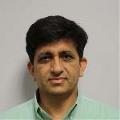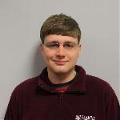Faculty
Dr. Muhammad Saleem
 Chair/Director Physics Program
Chair/Director Physics Program
Associate Professor of Physics
Ph.D., Physics, University At Albany (SUNY), New York, 2005
MS., Physics, University At Albany (SUNY), New York, 2001
M. Phil. Theoretical Particle Physics, Quaid-e-Azam University (Pakistan), 1996
BS., Physics, Math Punjab University (Pakistan); 1990
Research Interests: High Energy Physics, Astrophysics, Computation Science, Robotics
Office: Room 211A, Pasteur Hall
Phone: 502.272.8436
Email
Dr. Saleem is an academic & researcher in the areas of fundamental and applied science. He has published extensively in a wide range of key academic journals. He has worked at most of the leading national laboratories in the world: CLEO experiment at Cornell University, USA, Babar Experiment at Stanford Linear Accelerator Center (SLAC), USA, CERN in Switzerland.
As a member of the Atlas Collaboration at the Large Hadron Collider (LHC) at CERN in Geneva Switzerland, Dr. Saleem played important role in top quark physics, Charged Higgs boson (Discovery of the Higgs boson is a breakthrough discovery of the century in 2012 by the ATLAS collaboration at LHC – CERN. The Higgs), b-quark tagging and Atlas pixel detector electronics and software development. Dr. Saleem co-authored the discovery of the Higgs boson with the ATLAS Collaboration, discovery which provided the experimental basis for the Nobel Prize in Physics in 2013.
Dr. Saleem expertise at ATLAS at LHC include ATLAS Pixel Detector assembly, commissioning and Big Data analysis techniques in High Energy Physics using Machine learning. These data analysis techniques are critical for the challenging tasks involving Big Data (e.g., data analysis tasks from the Large Hadron Collider - LHC at CERN). The state-of-the-art machine learning techniques are used to search for rare signal events from the huge background events that arise from known physics processes at the LHC. These techniques are not only being used in the high energy physics experiments to discover new subatomic particles, but it is also used extensively in the growing Big Data industry and Artificial Intelligence methods.
Dr. Saleem is member of the Dark Energy Science Collaboration (DESC) at Robin/LSST. A large synoptic survey telescope being installed in Chile. Dr. Saleem’s expertise include photon simulation. These simulation data is produced on Bellarmine University’s Supercomputer and is provided to the DESC collaboration for analysis.
As a member of the Babar collaboration at Stanford Linear Accelerator Center (SLAC) – Stanford University, USA, which run the medium-energy particle-physics experiment called the BABAR experiment, where Dr. Saleem contributed to the operation of the experiment (having been Data Quality management and Electromagnetic Calorimeter operations coordinator) and to the data analysis. He co-authored the CP (Charge Parity) violation measurements with Babar Collaboration which provided the experimental basis for the Nobel Prize in Physics in 2008.
Dr. Saleem’s PhD studies were on the study of rare charm(quark) baryons at the BABAR experiment at Stanford Linear Accelerator Center facility (SLAC), CA, USA
Dr. Syed Ahmad
 Emeritus Professor of Physics
Emeritus Professor of Physics
Ph.D., Physics, Memorial University of Newfoundland (Canada), 1981
MS., Physics, Aligarh Muslim University (India); 1976
BS., Physics, Aligarh Muslim University (India); 1975
Research Interests: Physics Education
Office: Room 211, Pasteur Hall
Phone: 502.272.8436
Email
Bryan Fagan
 Physics Instructor
Physics Instructor
MS., Physics, University of Louisville, Louisville, KY, 2016
BS., Physics, Bellarmine University, Louisville, KY, 2014
Research Interest: Astronomy
Office: Room 157, Pasteur Hall
Phone: 502.272.8196
Dr. Akhtar Mahmood
 Professor of Physics
Professor of Physics
Ph.D., Physics, State University of New York at Albany, 1998
MSc., Physics, State University of New York at Albany, 1994
B.Sc., Computer Science (Honors), Edinboro University of Pennsylvania, 1992
Research Interests: High Energy Physics, Computational Science, Astrophysics
Office: Room 209B, Pasteur Hall
Phone: 502.272.7599
Email, Faculty Home Page, Research Page
Dr. Mahmood serves as the Director of the Bellarmine-STEM Program and also as the Director of the Eureka Learning Community (ELC). He is the ELC Academic Advisor of the Physics majors and is the undergraduate research mentor of all the physics majors. He manages Bellarmine University’s Supercomputer that is linked to the Open Science Grid (OSG). From 2009 - 2012 he served as the President of the Kentucky Association of Physics Teachers (KAPT) and from 2009 - 2013, he served as the Physics and Astronomy Section Chair of the Kentucky Academy of Science (KAS). He is currently serving on the Kentucky Academy of Science’s Committee on Science Education. He specializes in “Big Data” research. Dr. Mahmood studies the constituents of the early universe, when it was less than a micro-second old, using a particle accelerator (an atom-smasher). He is a member of the world-renowned ATLAS collaboration, a research team at CERN that recently announced the discovery of the famous Higgs boson (the subatomic particle that gives mass to everything in the universe). The discovery of the Higgs boson was hailed as the 2012 Breakthrough of the Year and is regarded as one of the major scientific discoveries of this century! Dr. Mahmood is currently pursuing the search for new types of subatomic particles using petabyte-scale experimental data from the ATLAS experiment. Several Physics undergraduate students are currently working with Dr. Mahmood on this research project in high energy physics. In collaboration with the Jet Propulsion Lab (JPL), along with his students, he also conducted research work (funded by NASA) with the SIM-Lite project, a future NASA mission aimed at searching for extra-solar Earth-like planets in the milky way galaxy.
Before joining Bellarmine University, Dr. Mahmood conducted his research work at the CLEO experiment at the CESR (Cornell Electron Storage Ring) accelerator facility, located at Cornell University and at BABAR experiment at SLAC (Stanford Linear Accelerator Center) located at Stanford University. In the late 1990s, his research work at CESR led to the discovery of eight new subatomic particles, known as Charmed Baryons. Since 1995, he has co-authored numerous peer-reviewed publications in the field of high energy physics, and has received over $2.0 million in research funding. At Bellarmine University, since 2010, he has received five external grants totaling over $1.1 million from NSF and NASA.
Dr. Tereza M. Paronyan, Ph.D.
 Physics Instructor
Physics Instructor
Ph.D., Physics, National Academy of Sciences of Armenia, Yerevan, Armenia, 2003
MS., Chemistry, Yerevan State University, Yerevan, Armenia, 1988
Research Interests: Solid State Physics: Carbon Nanotubes, Li-ion batteries, Solar Cells
Office: Room 211, Pasteur Hall
Phone: 502.272.8196
Email
Staff

Ms. Dawn Jewell
Secretary
Office: Room 006, Pasteur Hall
Phone: 502.272.8196
Email